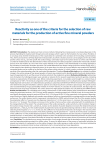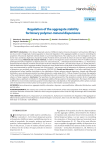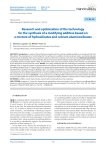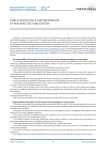Статьи журнала - Nanotechnologies in Construction: A Scientific Internet-Journal
Все статьи: 409

Статья научная
Introduction. The simplest and most common method of obtaining fine mineral powder is mechanical dispersion. In the process of grinding the material went through some work (energy), which is spent on the formation of a new surface. Therefore, it is not always clear whether the destruction of the crystal lattice of a solid lead to the activation of the resulting crushed material. Thus, the key characteristics of finely dispersed mineral powders, by which activation processes can be judged, are the value of the specific surface area (Ssp) and the specific free surface energy, numerically equal to the surface tension (σ) of the solid. Therefore, a number of models based on the determination of these characteristics have been proposed to estimate the mechanical activation process of the raw material. So, one of the most correct methods, in our opinion, is the method based on an energy approach to the evaluation of mechanical activation processes. This model determines the relative change in the free surface energy (ΔES/ES0) of the material when obtaining a dispersed system. At the same time, the choice of the most effective raw materials for obtaining composite binders can be carried out on the basis of the surface activity criterion (ks), which is used as a criterion characterizing the reactivity of fine mineral powders after their mechanical disintegration. Therefore, the aim of this study was to calculate the relative change in the surface energy of fine mineral powders of various raw materials and to identify possible functional relationship between the parameter ΔES/ES0 and the amount of surface activity for the studied rock systems. Methods and Materials. Sedimentary rocks formations the Arkhangelsk region were selected as materials for the research: polymineral sand and saponite-containing material (a representative of bentonite clays). Before conducting experiments, rock samples were brought to a constant mass at a temperature of 105оС. The chemical composition of the samples was determined on an X-ray fluorescence analyzer “Metexpert”. Highly dispersed rock fractions were obtained by dry grinding on a planetary ball mill Retsch PM100. The dimensional characteristics were determined using the DelsaNano submicron particle size analyzer by photon correlation spectroscopy. The specific surface area was determined by the gas permeability method on the PSX-10 device. To calculate the surface tension, the edge angle was measured on the “Easy Drop” installation. The surface tension for highly dispersed samples was calculated by the OWRK method. Results and Discussion. The calculated macro-energy characteristics of the studied samples have showed that the atomization energy for polymineral sand was 1910.72 kJ/mol, and for saponite–containing material was 1826.94 kJ/mol. At the same time, the mass specific atomization energy for sand and SCM are 30.41●103 kJ/kg and 26.94●103 kJ/kg, respectively. In the process of dispersion, several fractions of highly dispersed rock powders were obtained, which are characterized by an average particle size and specific surface area. The surface tension (and its components) calculated by the OWRK method showed that for all the samples studied, the polarization effect (σS P) prevails over the dispersion interaction (σS D). At the same time, as Ssp increases, the numerical value of the ratio σS P/σS D increases. This indicates an increase in the number of active surface centers associated with the redistribution of the energy potential of the system. The calculated values of free surface energy (ЕS), surface activity (ks) and the relative change in free surface energy showed, that ks and ΔES/ES0 increase as the duration of powder dispersion increases.The obtained functional dependences ks = f(ΔES/ES0) for the studied samples of polymineral sand and saponitecontaining material are linear in nature and obey the general equation у = a●x + b. In this case, the coefficient “a” characterizes the dynamics of changes in the reactivity of the material with an increase in the duration of mechanical grinding, and the parameter “b” – reactivity in the microstate. Comparison of the coefficients “a” of the studied dispersed systems showed that, unlike polymineral sand, the reactivity of saponitecontaining material increases 1.5 times faster as the grinding duration increases. The obtained functional relationship between the criteria used for evaluating the process of mechanical activation of mineral raw materials of various natures shows the correctness of the models used. Conclusion. The calculated macro-energy characteristics of rock samples showed that the atomization energy for polymineral sand and saponitecontaining material has similar values. To assess the effectiveness of the process of mechanical activation for mineral raw materials, it is proposed to use the relative change in free surface energy or surface activity.
Бесплатно

Regulation of the aggregate stability for binary polymer-mineral dispersions
Статья научная
Introduction. In the binary dispersed systems of different origins (mineral and polymer) with particles differing in size by an order of magnitude, heterocoagulation is observed. Regulation of the aggregate stability is crucial in controlling the properties of functional dispersed materials based on such mixed dispersions. This study focuses on the investigation of waterborne mono and binary dispersions of polyvinyl acetate, Portland cement, and chalk by means of static laser light scattering and optical microscopy. Materials and research methods. In order to investigate the action mechanism of the FF modifier based on phloroglucinol furfural oligomers as disperse phase we used chalk (CaCO3 – chalk dispersed technical MTD-2, LLC “Technostroy”, Kopanishchenskoe deposit), Portland cement CEM I 42.5N (JSC “Belgorod Cement”), and polyvinyl acetate (LLC “Kuban-Polymer”). Particle distribution and the aggregate stability of dispersions were studied with an Analysette 22 NanoTecplus device. The particle sizes were determined by optical microscopy with “Axio.Scope.A.1” microscope, and the adsorption of oligomers on the particles of dispersions was analyzed using a UV spectrometer (SPECORD UV). Results and discussion. It has been established that the phloroglucinol furfural modifier contributes to the stabilization of binary polymer-mineral dispersions. Integral and differential distribution curves of polymeric particles have been obtained in a wide range of 0.01–2100 μm. Research has shown the regularity of the modal diameter reduction of adsorption-modified particles with a transition from a narrow to a wider distribution with the absence of large coagulums. Conclusion. The hypothesis has been proposed that the adsorption-solvation factor of aggregate stability makes a significant contribution to the aggregate stability of binary polymer-mineral dispersions. The impact of this factor is different for mono-mineral and binary polymer-mineral dispersions and depends on the hydrophilicity of the surface, increases with the transition from mineral surface to the polymer surface as the Hamaker constant increases.
Бесплатно

Статья научная
Introduction. To improve the performance properties of lime coatings, modifying additives are introduced into their formulation. The development of a technology for the synthesis of an additive containing calcium hydro- and aluminosilicates, which promote the binding of lime and increase the resistance of the lime composite, is of current interest. Materials and methods. To prepare an additive based on a mixture of hydro silicates and calcium aluminosilicates, liquid sodium glass (GOST 13078), technical (purified) aluminum sulfate (GOST 12966), and quicklime were used. The pozzolanic activity of the materials was determined by the absorption of lime from lime mortar. Results. It has been established that the mineralogical composition of the additive obtained at the 1st stage of synthesis is represented by hydro silicates of the tobermorite group. The mineralogical composition of the additive obtained at the 2nd stage of synthesis is represented by hydro silicates of the tobermorite group, gypsum, and calcium aluminosilicates. The particle size of the additive is from 10 to 40 μm. The pozzolanic activity of the additive obtained at the first stage of synthesis was 238.6 mg/g, and that obtained at the second stage of synthesis was 3.2 times higher and amounted to 762.5 mg/g. The introduction of an additive obtained at the 2nd stage of synthesis into the composition increases the compressive strength of lime composites by 2.87 times. Conclusion. It is proposed to use a modifying additive obtained by a two-stage synthesis technology in heat-insulating DBM. The optimal concentration of the proposed modifying additive is selected, which is 10% by weight of lime.
Бесплатно

Статья научная
Results of a research of efficiency of sorbents on the basis of the waste of production and processing of micaceous quartzites (MQ), montmorillonite clays (MC) modified by humic connections (HC), received by extraction of waste brown coal are shown. Chemical composition of mica quartzite processing waste depending on the fraction size was previously investigated: element structure by method of the power-dispersive X-ray fluorescent analysis and mineral structure by method of X-ray phase analysis, for purpose of interrelation establishment between the structure of fraction and adsorptive properties of the received composite sorbents and also for the purpose of an exception as a part of MQ and, respectively, a sorbent of dangerous and toxic substances I-III of hazard classes. The efficiency of adsorption of the obtained sorbents was studied, an increase in sorption activity was found depending on composition of sorbent and method of modification (preliminary temperature processing and drawing on a surface of a sorbent of HC nano- and a microdimensional layer). It is determined that the greatest efficiency of adsorption of ions of heavy metals is observed for the sorbent which underwent temperature modification at 800оC and then HC covered with a layer up to 1% of masses. Use of waste of MQ containing 40–60% of quartz (SiO2) in composition with MC and with further modification of a surface (up to 1% of masses.) humic connections will allow receiving highly effective, universal and inexpensive sorbents for sewage treatment from heavy metals and other pollutants. The offered composite sorbents will allow to solve several ecologically important problems in a complex: to carry out effective purification of industrial sewage (machine and instrument-making, metallurgical, petrochemical and other enterprises) of heavy metals ions and to utilize waste of micaceous quartz processing of and brown coal extraction.
Бесплатно

















